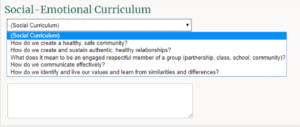Written by Andrea Fanjoy and Luis Correa-Power
Social and Emotional Learning Curriculum with Standards
By Andrea Fanjoy, Assistant Head of Academics at Kingsway College School in Canada
Since beginning mapping with Atlas, we introduced a new subject to be mapped and reviewed: social and emotional learning (SEL). According to the Collaborative for Academic, Social and Emotional Learning (CASEL):
“SEL is the process through which children and adults acquire and effectively apply the knowledge, attitudes and skills necessary to understand and manage emotions, set and achieve positive goals, feel and show empathy for others, establish and maintain positive relationships and make responsible decisions.”
A worthy subject, indeed. SEL is something KCS has always directly taught, but mapping it would allow us to better see what we do and improve our efforts. We decided that SEL would be a collaborative map, treated as one subject that all teachers within a grade were responsible for teaching. Within each grade level SEL course, subject-specific units were created to capture the different ways in which SEL was taught and addressed. For example, the ‘units’ in the SEL curriculum map for grade 7 included:
|
|
|
|
|
|
|
|
|
|
|
|
Most teachers captured their efforts as year-long units because SEL has become so integrated in our instruction and routines. For a few, however, the units took place at more specific times in the year, such as the Senior Kindergarten focus on learning the school rules from September to mid-October. The mapping alone was a revealing exercise, as teachers came to see the vast amount they do to develop these critical, though often overlooked, skills.
The whole-school review had faculty individually reading though the school’s SEL curriculum maps. They were asked to highlight or underline anything they didn’t realize was happening at the school, anything that appeared to be an opportunity, and anonymously record any other related thoughts or questions on their document.
You can see the more finalized social and emotional learning curriculum maps by clicking on the images below.
Class Meetings
English Language Arts
Mathematics
Template Examples for Designing Your Curriculum Map
Spark inspiration for next-level curriculum design with curriculum map examples from schools and districts across the world.
Social and Emotional Learning Curriculum with Reflection
by Luis Correa-Power, French, Spanish, and Human Development / Sexuality Education at Capitol Hill Day School, DC
The social-emotional category of our maps is a mere reflection of the extensive work we do in our school in this area. We discussed and decided on the drop-down menu as a way to simplify the work for teachers. However, the idea was also to expand, when necessary. See the category below:

The latter part, the expansion, is often captured in other categories, as well. In second grade, for instance, there are enduring understandings reflecting our social curriculum.
Examples include:
- Treating others with respect means valuing differences, listening to others, having patience, and speaking kindly at all times.
- Demonstrating empathy helps other people feel safe, cared for, and valued in the community.
- Taking care of our classroom and materials helps students be stewards of their space.
- Students feel valued when they are welcomed personally by others and feel like their voices are heard.
- Using clearly defined and established social courtesies help students navigate daily interactions (both in and out of school).
- Integrity and character are doing the right thing when no one is looking.
- Taking responsibility for your words and actions, regardless of others’ actions, fosters self-awareness and a healthy community.
- Fairness means that everyone gets what they need, not necessarily the same thing or what they want.
- Being kind to people is a non-negotiable.
- You’re not doing to always get your way, and that is okay.
- Keep trying, you don’t always get things right the first time. Mistakes are part of the learning process.
We can also find evidence of this in the Guidance or Counseling sessions (PK through 8th) as well as the Human Development / Sexuality Education classes (4th through 8th grades). Below you can see some examples, beyond the drop-down menu, that illustrate our social-emotional curriculum:
- In 7th grade, as part of a unit on Physiology, Physical and Emotional Changes:
- How do we identify and live our values and learn from similarities and differences?
- The focus of this session is mostly on similarities and differences when we experience physical and emotional changes
- In 8th grade, as part of a unit on Social Boundaries:
- Allow students to have the opportunity to discuss the social dynamics of the class and develop strategies that they can implement in order to reduce hurtful behaviors and division.
If you’re interested in adding similar categories to your school’s template, reach out to our Support team. And if you’re not (yet!) an Atlas client, learn more about the curriculum mapping platform featured in this blog.
[et_pb_cta button_url="https://www.onatlas.com/features#atlas" url_new_window="on" button_text="Learn More About Atlas" _builder_version="4.9.0" _module_preset="default" background_color="#FFFFFF" custom_button="on" button_text_color="#FFFFFF" button_bg_color="#d23831" background_layout="light" width="85%" module_alignment="center" custom_margin="||||false|false" custom_padding="12px||12px||false|false" border_radii="on|12px|12px|12px|12px" border_width_all="5px" border_color_all="#d23831"]Want to learn more about how Atlas can help you in documenting curriculum? Request a free demo or email us at [email protected]!
[/et_pb_cta]

